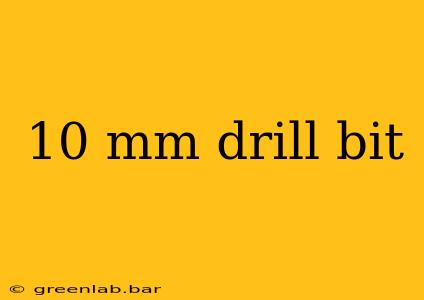A 10mm drill bit is a versatile tool found in countless workshops and DIY projects. Understanding its uses, choosing the right type, and mastering its application can significantly improve your drilling experience and project outcomes. This guide dives deep into everything you need to know about 10mm drill bits.
Understanding 10mm Drill Bits: Types and Materials
Before jumping into applications, let's clarify what makes a 10mm drill bit suitable for certain tasks. The key factors are the material it's made from and its specific design.
Drill Bit Materials:
-
High-Speed Steel (HSS): The most common type, HSS drill bits offer a good balance of strength, durability, and affordability. They are suitable for drilling into most common materials like wood, soft metals (aluminum, brass), and plastics. However, for tougher materials, they may require more effort and might wear down faster.
-
Cobalt HSS: An upgraded version of HSS, cobalt HSS drill bits contain cobalt, which significantly increases their hardness and heat resistance. This makes them ideal for drilling tougher materials like stainless steel, cast iron, and hardened steels. They're more expensive but offer superior longevity.
-
Titanium Nitride (TiN) Coated: TiN coating enhances the bit's hardness, wear resistance, and heat dissipation. This results in smoother drilling, increased lifespan, and improved performance in various materials. They are often a preferred choice for drilling metals.
-
Carbide Tipped: For extremely hard materials like masonry or tile, carbide-tipped drill bits are essential. The carbide tip is significantly harder than the underlying steel shank, allowing it to penetrate tough substances efficiently.
Drill Bit Types:
The standard 10mm drill bit is a twist drill bit, characterized by its spiral flutes. However, there are variations designed for specific applications:
-
Masonry Drill Bits: These have a carbide tip and are designed for drilling into brick, concrete, and stone. A 10mm masonry bit is useful for larger holes in these materials.
-
Wood Drill Bits: While a standard HSS 10mm bit works for wood, specialized wood bits (like Forstner bits or spade bits) offer cleaner cuts and potentially larger hole sizes.
Choosing the Right 10mm Drill Bit for Your Project
Selecting the appropriate 10mm drill bit depends heavily on the material you're drilling into:
- Wood: An HSS twist drill bit is usually sufficient.
- Soft Metals (Aluminum, Brass): HSS is generally adequate.
- Hard Metals (Steel, Stainless Steel): Cobalt HSS or TiN-coated HSS is recommended.
- Masonry (Brick, Concrete): A carbide-tipped masonry drill bit is essential.
- Plastics: HSS usually works well, but selecting a bit with a sharper point can prevent chipping.
Using a 10mm Drill Bit Safely and Effectively
Proper drilling techniques are crucial for both safety and achieving accurate results:
- Use the correct speed: Consult your drill's manual for appropriate speed settings for different materials. Generally, slower speeds are better for harder materials.
- Apply firm, even pressure: Avoid excessive force, which can break the bit or cause damage to the workpiece.
- Use cutting fluid (when necessary): Cutting fluid, such as oil or water-soluble coolant, helps to lubricate the bit, reduce friction, and prevent overheating, especially when drilling metals.
- Ensure proper clamping: Secure your workpiece firmly to prevent movement during drilling.
- Wear safety glasses: Always protect your eyes from flying debris.
Maintenance and Storage
Proper maintenance extends the life of your 10mm drill bits:
- Clean the bit after each use: Remove debris from the flutes using a brush or compressed air.
- Sharpen dull bits (if possible): HSS bits can be sharpened using specialized tools.
- Store bits in a safe and organized manner: A drill bit organizer or case prevents damage and ensures easy access.
This comprehensive guide provides a solid foundation for understanding and using 10mm drill bits effectively and safely. Remember to always prioritize safety and choose the right bit for the specific material you're working with.

